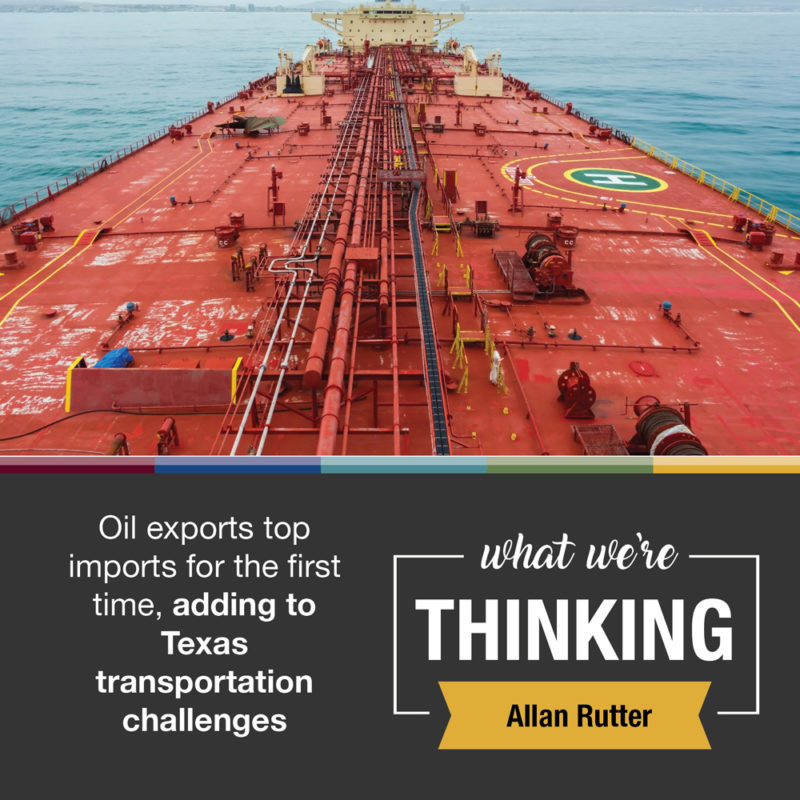 By Allan Rutter
By Allan Rutter
In the last week of November 2018, daily exports of U.S. oil, gasoline and other products exceeded imports for the first time in nearly 70 years, thanks in large part to energy-rich Texas. But despite appearances, the boom of the state’s oil and gas production will not halt the flow of oil imports to the refineries on the Texas coast.
The crude oil being pumped from the Permian Basin of West Texas is light crude. Our refineries along the Gulf Coast use a mix of crude oils (light, medium and heavy) to produce a variety of fuels; almost all light crude used in Gulf Coast refineries is now produced domestically, but heavier density crude oils are still imported. So the next time you gas up at Buc-ee’s or 7 Eleven, and for a long time thereafter, some of what you buy will have originated in Canada, Mexico, or Venezuela.
While producing more oil and gas than we import doesn’t necessarily make us energy independent, it does, however, help to increase our manufacturing strength and boost our economy. That, in turn, increases our transportation needs.
The production of polyethylene, used to make plastic bottles and myriad other consumer goods is fueled by natural gas, both as a feedstock and a power source. This gas is more abundant and economical than ever, thanks in large part to the booming production levels in the Permian Basin. That gives American manufacturers like those along the Texas Gulf Coast a big cost advantage over producers in Asia and elsewhere. As a result, much of what we produce is exported. Thousands of tons of plastic pellets leave Texas by ship, but even more go by the trainload and truckload to East and West Coast ports, destined for Europe and Asia. Transporting all that plastic product adds to the freight congestion that strains roadway capacity near and far beyond those ports.
Cheap natural gas is also ramping up the steel industry, notably at a plant in the Port of Corpus Christi, where nearly a quarter million tons of iron ore are processed each month. The transformed product – cleaned iron – is destined for other plants that turn it into high-quality steel, which is then shipped to Germany to produce BMWs, Mercedes-Benzes, and Porsches. Luxury automakers, as they add more electronic features (and heft) to cars, need greater volumes of that top-shelf steel to reduce weight, while still preserving high levels of safety. With natural gas costs far lower in the U.S. than in Europe, this trend is likely to continue, contributing to higher levels of seaport traffic.
Thriving energy production in Texas, however, isn’t limited to oil and gas. Take a drive through West Texas, and you’re likely to see that wind farms are as expansive as drilling fields. One such farm in Ector County near Notrees (no kidding; that’s the town’s name) draws enough power from 95 turbines to power more than 40,000 homes. Those giant turbine blades, sweeping a vertical space of roughly an acre, are manufactured mostly in Europe and China. As wind-generated power is expected to grow as a share of our overall electricity production, we can expect a lot more of those giant blades to make their way here, generating more cargo ship trips to Gulf Coast ports, and more wear and tear on the roads to get the turbines and blades to places where windy days are the norm. That’s no small feat, as the long and heavy-load trips from the Gulf Coast to West Texas can take upward of four days.
All of this activity is placing ever-growing burdens on our seaports and the broader surface transportation network that extends from them. Fortunately, the flow of oil and gas creates a corresponding flow of cash to state coffers in the form of oil and natural gas severance taxes. So long as the state’s Economic Stabilization Fund (or Rainy Day Fund) has a balance of at least $7.5 billion, half of any additional oil and gas earnings go to the State Highway Fund. Today’s Rainy Day Fund balance is more than $12 billion. In booming times like these, that means billions available for road building and maintenance. But in a state the size of ours, even billions won’t necessarily immediately fix all of Texas’ transportation needs.
At this point, America can boast a few weeks of exporting more oil than we imported. Who’s to say whether that’s the start of a trend, or just a noteworthy milestone? Regardless of how fast we become less dependent on foreign oil imports, we’re becoming more dependent on a system of seaports, highways, and railways to meet the needs of our growing and evolving energy production industry.
This story was originally published in the Caller Times (USA Today network) website on Jan. 31, 2019.
Allan Rutter heads the Freight and Investment Analysis Division at the Texas A&M Transportation Institute (TTI), and he is a former Administrator of the Federal Railroad Administration.